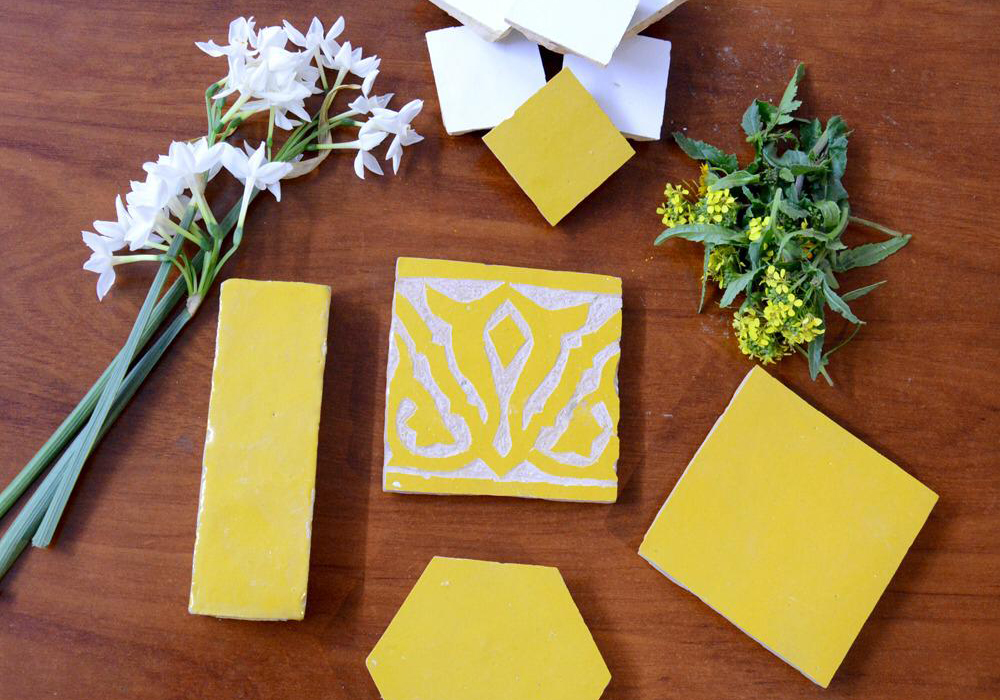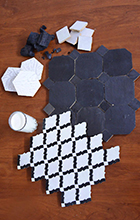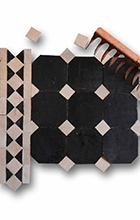
History of Zellige
It is possibly dating from the mid-10th century Fatimid foundation, that information suggests that the technique may have developped in the western islamic world and by the 11th century the zellige technique had reached a sophisticated level as seen at Qalaat Beni Hammad in Algeria. Relatively simple in design prominent bands of ceramic decoration in white and green were features on Kutubiyya Mosque, which is the largest mosque in Marrakech also reffered to as Mosque of the Booksellers or Kutubiya Mosque and located in the southwest of medina quarter and Kasbah Mosque also in Marrakesh it is believed that they may have reflected artistic influences from Sanhaja Berber culture. This framework of expression within the conceptual framework of islamic art which valued the creation of spatial decorations that avoided depictions of living things. Consistant with taboos on such depictions in religious settings.
 Zellige tiles are crafted from clay found in the city of Fez, Morocco. After a grid is formed, artisans then press the mixture into squares and let it dry out to form slabs. The craftsmen use a shaping block and hammer to smooth the tile and cut it into a more precise shape and size
Zellige tiles are crafted from clay found in the city of Fez, Morocco. After a grid is formed, artisans then press the mixture into squares and let it dry out to form slabs. The craftsmen use a shaping block and hammer to smooth the tile and cut it into a more precise shape and size
The most complex style of zellige known today was invented in the 14th century during the Nasrid and Zayyanid dynasty periods in Morocco and al-Andalus. The old enamels with the natural colors were used until the beginning of the 20th century. It has been inspired from Bazintine mosaics and adapted afterwards ny muslim craftsmen for faience tiles. These are found in famous buildings of the period such as the Alhambra palaces of the Nasrids and schools in Fes, Meknes and Salé, by this time more colors were implemented such as various shades of yellow and blue and brown, these new colors allowed craftsmen to be more creative in the shapes and sizes of zellige, so by this way more complex patterns and motifs were formed. It was in Andalusia and Morocco that the art of zellige was properly nurtured to the point where the moroccan tile became almost synonymous with moorish architecture, with beautiful and intiricate designs filling exterior and interior spaces alike.
 Historically speaking, zellige has always been favored by the afluent, decorative cement tiles were offered as a much cheaper alternative but they could not possibly match the exquisiteness and pure beauty of the true zellige. Nowadays Morocco is the epicenter of the craft, with the city of Fez hosting some of the most skilled ans talented craftsmen that give birth to proffesionally handmade moroccan tilework in accordance with time honored tradition of zellige and the results are breath-taking.
Historically speaking, zellige has always been favored by the afluent, decorative cement tiles were offered as a much cheaper alternative but they could not possibly match the exquisiteness and pure beauty of the true zellige. Nowadays Morocco is the epicenter of the craft, with the city of Fez hosting some of the most skilled ans talented craftsmen that give birth to proffesionally handmade moroccan tilework in accordance with time honored tradition of zellige and the results are breath-taking.
Zellige has now gained more fame since most people want to have an aesthetic look to their home, and it has gotten better and better over the years and more sophisticated and complex and not to mention that it has gotten much cheaper since the old days where only the rich can afford it.


